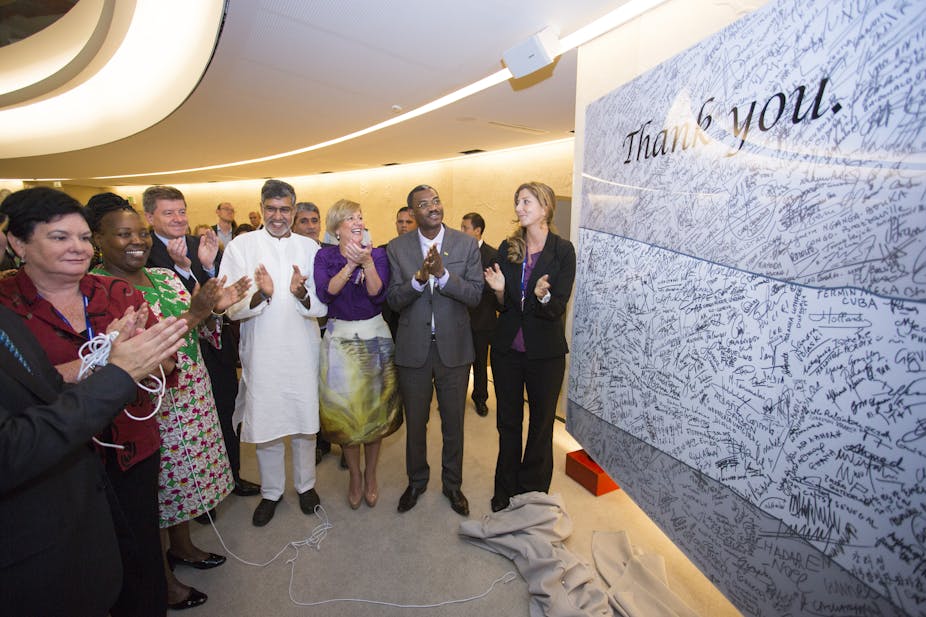Today a vast number of children – defined as anyone under 18 by the UN Convention on the Rights of the Child – work in Europe. There could be as many as 7.5 million children working for pay, profit or family gain across the continent. The socioeconomic crisis that began in 2008 has made the problem worse: trade unions, the media and UNICEF have all reported that an increasing number of children are dropping out of school to take care of siblings or serve as farm labourers, shop assistants, or join local mafias – working as panhandlers, prostitutes or drug dealers.
The Council of Europe’s Commissioner for Human Rights, Nils Muižnieks, has highlighted that the austerity measures in several European countries have had a direct impact on child labour, especially in hazardous occupations such as agriculture and construction. Even when children work lawfully, horrific injuries can occur, and even death.
What can be done?
The appropriateness of children working has long been debated, and the responses depend on many factors. “Abolitionists” or “welfarists” advocate removing children from work environments, especially when it may be detrimental to their development, arguing they should receive education and socio-cultural development through other means. “Regulationists” or “autonomists” favour regulation of child work and furthering children’s range of choices, so satisfying children’s wishes to be socially independent and contribute to their families’ well-being.
Terminology is important here. When work becomes detrimental to children’s psychological and physical development, the notion of “child labour” can be used. While in some cases the term “child work” may be acceptable (especially in the case of older children), the expression “child labour” is generally used only for those cases where the work in question is legally or morally unacceptable.
When children are sufficiently skilled, the work environment is safe and the employer’s supervision is appropriate, then child work may be acceptable, and so simply be considered “child work”. Only when it somehow harms the child’s development does it become “child labour”. Where exactly this threshold is crossed will always be contentious even within Europe – let alone at a global scale.
Politicians need to be more assertive on this question. As reflected in the work of the International Labour Organization and the European Commission, it has long been known that both children and wider society reap enormous benefits when education is prioritised over work. Yet this should not be seen as the primary aim of stricter child-labour policies, but simply as a positive side effect. The cornerstone of policy-making should be the children’s rights and well-being.
In the European context, there are sufficient resources – political will allowing – to ensure that all children can concentrate on their education and not on work. Keeping children’s future employment prospects in mind, vocational training or traineeships are much more valuable than the type of unskilled and poorly paid work that most working children carry out.
One may criticise this stance by saying that it limits children’s autonomy and their right to participate in society, but the autonomy of adult workers is similarly curtailed for legitimate reasons – for example, by EU rules on working time and pregnancy. So there is no reason why children’s autonomy may not also be curtailed in their best interests – something required by Article 3 of the UN Convention on the Rights of the Child.
A role for the EU
The European Union can play a key role in leading the fight against the negative consequences involved with work carried out by children. The Young Workers Directive needs to be amended to reach the international standards.
There is clear scope for improvement of the directive:
It should apply to all work by children, not just formal employment;
The general minimum employment age should be raised from 15 to 16 at the very least;
Terms such as “dangerous work” and “light work” should be more clearly defined;
Member states should be required to gather hard data and implement the rules through rigorous inspection procedures, as labour inspection services have historically been deficient in relation to child work.
These amendments would reduce the number of loopholes and, more importantly, make the Young Workers Directive that much stricter.
The EU can do all this on the basis of its labour law-making competence, but it alone cannot ensure that children have the educational opportunities and the social safety net required to preclude the need and motivation to work.
It is for EU member states to ensure that appropriate educational and welfare systems are in place, and that can only happen if national budgets are not prey to drastic austerity measures. By following these recommendations, we will be on a better path to liberating children from life-long cycles of low qualifications, low skills and low income.


